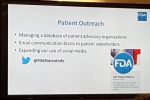Seminar Danish Embassy Brussels 17 September 2018
Seminar Danish Embassy Brussels 17 September 2018
Report Seminar Danish Embassy Brussels 17 September 2018

On the 18th of September 2018 we were invited to participate in the seminar “Rethinking healthcare systems in Europe: how to utilize patient’s perspective”.
Summary
Speakers presented a range of national, international and disease-specific initiatives to increase patient involvement and empowerment in healthcare systems. They emphasised the importance of incorporating the patient perspective, including solid data, at all stages of drug development and patient access decisions, and for professionals to be open to the input.
In the second part of the seminar, panellists from various professional backgrounds identified some of the factors influencing the trend towards greater patient involvement and the issues these raise. These included strong calls for reform of the current standards for clinical trials, more emphasis on quality of life and patient relevant outcomes and greater use of digitisation and standardisation in improving healthcare.
Presentations
Christine Janus, CEO, GlobalSkin, International Alliance of Dermatology Organisations
Understanding the impact of disease from the patient perspective
Dermatological diseases are invisible, minimised, stigmatised, and misunderstood by decision makers. To address some of these obstacles, the alliance has developed the first patient-initiated global study GRIDD (Global Research on the Impact of Dermatological Diseases). This methodology systematically challenges the traditional Global Burden of Disease concept by including patient driven-research and perspective strongly in burden metrics.
Prof. Dr. Matthias Augustin, University Medical Centre Hamburg-Eppendorf
People-centred model of care is necessary. This requires raising awareness, providing good quality patient care and better access to affordable healthcare. Germany has responded by establishing the 2018-2020 ECHT – a programme against stigmatisation of people with chronic visible skin diseases. A Bundestag task force also meets twice a year with dermatologists and patients, serving as a best practice example of the roll out of the WHO resolution on psoriasis.
Christine Foltmar Gammelgaard, Head of Section, Ministry of Health of Denmark
The Danish Digital Health Strategy: the patient as an active partner
Digitisation in healthcare has great potential for improving quality of care by interconnecting patient pathways across sectors, providing care for patients in their own home and enabling individualised treatment. These benefits make it possible to channel limited resources to areas of most need.
In January 2018, Denmark launched a 2018-2022 digital health strategy. It has five focus areas. The first – “The patient as an active partner” – aims to bring the healthcare system closer to patients, empower them and give them access to a complete overview of their own treatment and data.
In 2016, the government, in agreement with regions and municipalities, established a national steering group for Patient Reported Outcomes (PRO). National PROs are being developed and their use is encouraged across sectors both actively for patient and healthcare provider interaction and for quality purposes.
https://www.sum.dk/Aktuelt/Publikationer/A-Coherent-and-Trustworthy-Health-Networkfor-All.aspx, www.PRO-danmark.dk/da/pro-english
Isabel Proano Gomez, Director of Policy and Communications, European Federation of Allergy and Airways Diseases Patients Associations (EFA)
Case: Improving Quality of Life data – Results of first European survey on Atopic Eczema
The EFA has recently produced a new landmark report covering nine European countries, Itching for Life: Quality of Life and costs for people with atopic eczema in Europe. The initiative aims to give a voice to patients, to understand the burden of such diseases and to raise awareness of the need for appropriate medical responses.
The survey was conducted according to Quality of Life (QoL) and economic impact methods. The federation developed a new validated tool: The Atopic Eczema Score of Emotional.
Consequences (AESEC). The new patient-driven methodology revealed findings such as fourfifths of patients with severe atopic eczema had other diseases and that diagnosis and emotional impact of eczema varies from country to country.
The report’s recommendations are to look beyond the skin, provide holistic care, educate and improve acceptance to reduce suffering, involve patients and their advocates in research, support and patient-oriented outcomes from the beginning.
Andrea Furia-Helms, M.P.H., Director, Patient Affairs Staff, FDA – USA
Incorporating the patients’ perspective, experience from regulatory authorities
The Patient Affairs Staff (PAS) was established in December 2017, although patient engagement at the FDA began in 1988, prompted by HIV/AIDS. The PAS works closely with medical product centres and other offices to support patient involvement. It helps patients and their organisations navigate the FDA and the regulatory process. It works closely with the European Medicines Agency – some 20 EMA/FDA clusters now exist.
The most recent PAS initiative is the Patient Engagement Collaborative (the inaugural meeting was held on 29 August 2018). This established an external group of patient organisations and individual representatives, modelled on the EMA’s patients’ and consumers’ working party. It introduces a proactive process to enhance patient engagement in medical product development and regulatory discussions in the FDA.
The PAS is involved in cross-cutting programmes. This has led to the formalisation of the rare disease listening pilot project and increased patient experience input into regulatory discussions.
The FDA is developing its communication with patients by improving its website, managing a database of patient advocacy organisations and creating a central point for patient enquiries. The agency operates a patient representative programme for interaction between patients and stakeholders and has established externally-led patient-focused drug development meetings where patients take the initiative.
Dr. Hans-Georg Eichler, Senior Medical Officer, EMA
The EMA, from its very beginning in 1995, has included the patient voice at various levels in its work. Patients review product information to determine whether they are comprehensible. They act as experts to input their experience and identify issues of importance to them, while PROs are considered in drug evaluations. Patients have a seat on some committees and a vote on the decisions taken.
PROs identify issues relevant and important to patients and can be used to weigh trade-offs of risk-benefit ratios. More use of discrete choice methods are welcomed to allow the EMA to make the most relevant choice when assessing the risk-benefit ratio of a drug.
Panel
How to incorporate patients’ perspective and the role of PROs in future healthcare in Europe.
An hour-long panel discussion with representatives from different branches of the medical sector identified the following issues:
- Patient involvement was widely supported with particular emphasis on meaningful participation at the earliest possible stages of policy or programme development. The key question is “how is that best done?” Patient involvement is gaining political momentum with many national initiatives taking place. However, these are scattered in various areas of healthcare. While patients are represented with a seat on many committees, further progress could still be made in truly incorporating their views on drug development and drug access issues.
- PROs are needed to establish the full patient and societal burden of disease. They should be widely used across the board to achieve better investment decisions.
- Clinical trials attracted a great deal of criticism in their current format, which was accused of being largely driven by cost factors. The methodology should be rethought and the pharmaceutical industry develop better understanding of patients. This requires a more sophisticated set of inputs, with the inclusion of PROs in the initial design and more prominence given to quality of life outcomes.
- Digitisation enables monitoring, evaluation, screening and consultation in the patient’s home, saving time and costs for health services and increasing patient empowerment. Its use increases the efficiency of medical services at a time of rising demand.
- Standardisation and a common framework are needed to give an EU-wide structure to the many fragmented initiatives on patient involvement, PRO and patient relevant outcomes now taking place. This would help to develop common strategies.
- Awareness of developments taking place in other areas and countries can help promote patient involvement. The OECD’s Patient Reported Indicator Survey (PaRIS), launched in 2017, is providing useful comparable data for policy makers. These should not be used for public benchmarking or league tables. Instead, they help identify system-related factors impacting on people’s lives.
- The EU’s Innovative Medicines Initiative already involves patients in many ways. They can be full or associated project partners, members of advisory committees or propose research. This enables them to present their needs, help design the clinical trial and have access to early involvement with regulators.
- Joined-up thinking between patient and healthcare providers is required to increase patient involvement and empowerment. The example was given of The Netherlands where a three-pronged policy focuses on more shared decision making in the consultation room, establishment of personal health records maintained by patients themselves and use of defined outcome measurements in which PROs are prominent.
- More trade-offs involving patient data would help improve risk benefit evaluations. Greater attention should be given to quality of life consequences when considering the medical outcomes of new drugs. This could involve debate between risk averse or risk tolerant approaches. Patients might complain if a drug with possible adverse consequences is not authorised. Yet at the same time, they may not have a clear understanding of unknown risks, or overestimate the benefits, when a drug is given fast track approval. Given the dilemma, one participant stressed that patients should be informed about any level of uncertainty attached to a drug.
- Terminology plays a role. The OECD increasingly uses the term “people” since it is a wider concept than the more medical term “patients”. However, it was pointed out that people with a disease and those without often have different perceptions and that one term for both groups may not be appropriate.












